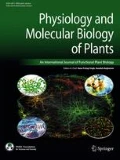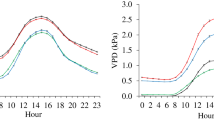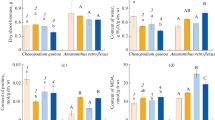Abstract
Effect of different photosynthetic photon flux densities (0, 500, 1000, 1500 and 2000 μmol m−2s−1), temperatures (20, 25, 30, 35 and 40 °C) and CO2 concentrations (250, 350, 450, 550, 650 and 750 μmol mol−1) on gas and water vapour exchange characteristics of Cannabis sativa L. were studied to determine the suitable and efficient environmental conditions for its indoor mass cultivation for pharmaceutical uses. The rate of photosynthesis (PN) and water use efficiency (WUE) of Cannabis sativa increased with photosynthetic photon flux densities (PPFD) at the lower temperatures (20–25 °C). At 30 °C, PN and WUE increased only up to 1500 μmol m−2s−1 PPFD and decreased at higher light levels. The maximum rate of photosynthesis (PN max) was observed at 30 °C and under 1500 μmol m−2s−1 PPFD. The rate of transpiration (E) responded positively to increased PPFD and temperature up to the highest levels tested (2000 μmol m−2s−1 and 40 °C). Similar to E, leaf stomatal conductance (gs) also increased with PPFD irrespective of temperature. However, gs increased with temperature up to 30 °C only. Temperature above 30 °C had an adverse effect on gs in this species. Overall, high temperature and high PPFD showed an adverse effect on PN and WUE. A continuous decrease in intercellular CO2 concentration (Ci) and therefore, in the ratio of intercellular CO2 to ambient CO2 concentration (Ci/Ca) was observed with the increase in temperature and PPFD. However, the decrease was less pronounced at light intensities above 1500 μmol m−2s−1. In view of these results, temperature and light optima for photosynthesis was concluded to be at 25–30 °C and ∼1500 μmol m−2s−1 respectively. Furthermore, plants were also exposed to different concentrations of CO2 (250, 350, 450, 550, 650 and 750 μmol mol−1) under optimum PPFD and temperature conditions to assess their photosynthetic response. Rate of photosynthesis, WUE and Ci decreased by 50 %, 53 % and 10 % respectively, and Ci/Ca, E and gs increased by 25 %, 7 % and 3 % respectively when measurements were made at 250 μmol mol-1 as compared to ambient CO2 (350 μmol mol−1) level. Elevated CO2 concentration (750 μmol mol−1) suppressed E and gs ∼ 29% and 42% respectively, and stimulated PN, WUE and Ci by 50 %, 111 % and 115 % respectively as compared to ambient CO2 concentration. The study reveals that this species can be efficiently cultivated in the range of 25 to 30 °C and ∼1500 μmol m−2s−1 PPFD. Furthermore, higher PN, WUE and nearly constant Ci/Ca ratio under elevated CO2 concentrations in C. sativa, reflects its potential for better survival, growth and productivity in drier and CO2 rich environment.
Similar content being viewed by others
Abbreviations
- PPFD:
-
Photosynthetic photon flux density
- PN :
-
Photosynthesis
- Rd:
-
Dark respiration
- PN max :
-
Maximum rate of photosynthesis
- E:
-
Transpiration
- gs :
-
Leaf stomatal conductance
- Ci:
-
Leaf internal CO2 concentration
- Ci/Ca:
-
Internal to ambient CO2 concentration
- WUE:
-
Water use efficiency
References
Aguirre-von Wobeser E, Figueroa FL and Calello-Pasini A (2000). Effect of UV-B radiation in photoinhibition of marine macrophytes in culture systems. J. Appl. Phycol., 12: 159–168.
Alexander JD, Donnelly JR and Shane JB (1995). Photosynthetic and transpirational response of red spruce an understory tree to light and temperature. Tree Physiol., 15: 393–398.
Ayuko U, Tadahiko M and Amane M (2008). Effects of temperature on photosynthesis and plant growth in the assimilation shoots of a rose. Soil Sci. Plant Nutrition, 54: 253–258.
Bazzaz FA and Garbutt K (1988). The response of annuals in competitive neighborhoods: Effect of elevated CO2. Ecology, 69: 937–946.
Berry J and Bijorkman O (1980). Photosynthetic response and adaptation to temperature in higher plants. Ann. Rev. Plant Physiol., 31: 491–543.
Berry JA and Downtown WJS (1982). Environmental regulation of photosynthesis. In: Development carbon metabolism and plant productivity, vol. II (ed. Govindgee ), Academic press, New York, pp. 263–343.
Bowes G (1993). Facing the inevitable: Plant and increasing atmospheric CO2. Annu. Rev. Plant Pysiol. Plant Mol. Biol., 44: 309–332.
Brenneisen R, Egli A, ElSohly MA, Henn V and Spiess Y (1996). The effect of orally and rectally administered D9-tetrahydrocannabinol on spasticity. A pilot study with two pettients. Internat. J. Clin. Pharmacol. Therap., 34: 446.
Cure JD (1985). Carbon dioxide doubling response: A crop survey. In: Direct effect of CO2 on vegetation (Eds. Strain BR and Cure JD), US Department of Energy Washington, pp: 99–116.
Cure JD and Acock B (1986). Crop response to carbon dioxide doubling: A literature survey. Agric. For. Meteorol., 38: 127–145.
Dieleman JA and Meinen E (2008). Interacting effects of temperature integration and light intensity on growth and development of single-stemmed cut rose plants. Scientia Hort., 113: 182–187.
Doyle E and Spence AA (1995). Cannabis as a medicine? Brit. J. Anaesth., 74: 359–361.
Drake BG, Gonzalez-Meler MA and Long SP (1997). More efficient plants: A consequence of rising CO2? Annu. Rev. Plant Physiol. Plant Mol. Biol., 48: 609–639.
Eamus D, Berryman DA and Duff GA (1993). Assimilation, stomatal conductance, specific leaf area and chlorophyll responses to elevated CO2 of Maranthes corymbosa, a tropical monsoon rain forest species. Aust. J. Plant Physiol., 20: 741–755.
Formukong EA, Evans AT and Evans F (1989). The medicinal uses of Cannabis and its constitutents. J. Phytother. Res., 3: 219–231.
Grinspoon L and Bakalar JB (1993). Marihuana, the forbidden medicine. Yale University Press, New Haven.
Hammond CT and Mahlberg PG (1977). Morphogenesis of capitate glandular hairs of Cannabis sativa (Cannabaceae). Amer. J. Bot., 64: 1023–1031.
Idso KE and Idso SB (1994). Plant responses to atmospheric CO2 in the face environmental constituents: A review of past ten years’ research. Agric. Forest Meteorol., 69: 153–203.
Jones HG (1992). Plants and microclimate: Quantitative approach to environmental plant physiology. IInd ed., Cambridge University Press, Cambridge.
Joshi SC and Palni LMS (1998). Clonal variation in temperature response of photosynthesis in tea. Plant Sci., 13: 225–232.
Joshi SC and Palni LMS (2005). Greater sensitivity of Hordeum himalayens Schult. to increasing temperature causes reduction in its cultivated area. Curr. Sci., 89: 879–882.
Kimball BA (1983a). Carbon dioxide and agricultural yield: An assemblage and analysis of 430 prior observations. Agron. J., 75: 779–788.
Kimball BA (1983b). Carbon dioxide and agricultural yield: An assemblage and analysis of 770 prior observations. Water conservation lab report 14, US water conservation lab. USDA-ARS, Phoenix, AZ, pp. 71.
Kimball BA (1986). Influence of elevated CO2 on crop yield. In: Carbon dioxide enrichment of greenhouse crops. Vol. 2: Physiology yield and economics (eds Enoch HZ and Kimball BA), CRC Press, Inc. Boca Raton, FL., pp. 105–115.
Kruse J, Hopmans P and Adams MA (2008) Temperature responses are a window to the physiology of dark respiration: differences between CO2 release and O2 reduction shed light on energy conservation. Plant Cell Environ., 31: 901–914
Long SP, Ainworth EA, Rogers A and Ort DR (2004). Rising atmospheric carbon dioxide: Plant face the future. Annu. Rev. Plant Biol., 55: 591–6287.
Mattes RD, Shaw LM, Eding-Owens J, Egelman K and ElSohly MA (1993). Bypassing the first pass effect for therapeutic use of cannabinoids. Pharmacol. Biochem. Behav., 44: 745–747.
Mattes RD, Egelman K, Shaw LM and ElSohly MA (1994). Cannabinoids appetite stimulation. Pharmacol. Biochem. Behav., 49:187.
Mechoulam R (1986). Cannabinoids as therapeutic agents. CRPS Press, Boca Raton.
Mechoulam R and Ben-Shabat A (1999). From gan-zi-gun-nu to anandamide and 2-arachidonoylglycerol: the ongoing story of Cannabis. Nat. Prod. Rep., 16: 131–143.
Monclus R, Dreyer E, Villar M, Delmotte FM, Delay D, Petit JM, Barbaroux C, Thiec DL, Brechet C and Brignolas F (2006). Impact of drought and productivity and water use efficiency in 29 genotypes of Populus deltoids x Populus nigra. New Phytol., 169: 765–777.
Morison JIL (1993). Response of plants to CO2 under water limited conditions. Check Vegetatio., 104/105: 193–209.
Osmod CB (1994). What is photoinhibition? Some insights from comparisons of shade and sun plant. In: Photoinhibition of photosynthesis, from molecular mechanisms to the field. (Eds. Baker NR and Bowyner NR), BIOS Sci. Publ., Oxford. pp. 1–24.
Pearcy RW (1977). Acclimation of photosynthetic and respiratory carbon dioxide exchange to growth temperature in Atriplex tentiformus (Torr.) Wats. Plant Physiol., 59: 795–799.
Poorter H (1993). Inter-specific variation in the growth response of plant to an elevated CO2 concentration. In: CO2 and Bispherre (Eds. Rozema J, Lambers H, Van de Geijn SC and Cambridge ML), Kluwer Acaemic Publication, Boston, MA., pp: 77–97.
Prentice IC, Farquhar GD, Fasham MJR, Goulden M, Heinmann M, Jaramillo VJ, Kheshgi HS, Le Querere C, Scholes RJ and Wallace DWR (2001). The carbon cycle and atmospheric carbon dioxide. In: Climatic change 2001: The scientific basis. Contribution of working group 1 to the third assessment report of the intergovernmental panel of climatic change (Eds. Houghton JT, Ding Y, Griggs DJ, Noguer M, ver der Linden PJ and Xiaosu D), Cambridge University Press, Cambridge, pp. 183–238.
Rawson HM, Begg JR and Woodward RG (1977). The effect of atmospheric humidity on photosynthesis, transpiration and water use efficiency of leaves of several plant species. Planta, 134: 5–10.
Schulze ED, Lange OL, Buschbom U, Kappen L and Evenari M (1972). Stomatal response to change in humidity in plants grown in the desert. Planta, 108: 250–270.
Sheshshayee MS, Krishna Prasad BT, Natraj KN, Sankar AG, Prasad and Udayakumar M (1996). Ratio of intercellular CO2 concentration of mesophyll efficiency. Curr. Sci., 70: 672–675.
Singh A and Purohit AN (1997). Light and temperature effects on physiological reactions on alpine and temperate populations of Podophyllum hexandrum Royle. J. Herbs Spices Med. Plants, 5: 57–66.
Sirikantaramas S, Taura F, Tanaka Y, Ishikawa Y, Morimoto S and Shoyama Y (2005). Tetrahydrocannabinolic acid synthase, the enzyme controlling marijuana psychoactivity is secreted into the storage cavity of the glandular trichomes. Plant Cell Physiol., 46: 1578–1582.
Stoutjesdijk P and Barkman JJ (1992). Microclimate, Vegetation and Fauna., Opulus Press Pub., Sweden.
Thomas RB, Lewis JD and Strain BR (1994). Effect of leaf nutrient status on photosynthetic capacity in loblolly pine (Pinus taeda L.) seedling grown in elevated CO2. Tree physiol., 14: 947–960.
Thornton MK, Malik NJ and Dwelle RB (1995). Relationship between gas exchange characteristics and productivity of potato clones grown at different temperatures. Check A. Potato J., 73: 63–77.
Yao X, Liu Q and Han C (2008). Growth and photosynthetic responses of Picea asperata seedlings to enhanced ultraviolet-B and to nitrogen supply. Brazilian J. Plant Physiol., 20: 11–18.
Zelitch I (1975). Improving the efficiency of photosynthesis. Science, 188: 626–633.
Zuardi AW (2006). History of Cannabis as a medicine: a review. Rev. Bras. Psiquiatr., 28: 153–157
Author information
Authors and Affiliations
Corresponding author
Rights and permissions
About this article
Cite this article
Chandra, S., Lata, H., Khan, I.A. et al. Photosynthetic response of Cannabis sativa L. to variations in photosynthetic photon flux densities, temperature and CO2 conditions. Physiol Mol Biol Plants 14, 299–306 (2008). https://doi.org/10.1007/s12298-008-0027-x
Published:
Issue Date:
DOI: https://doi.org/10.1007/s12298-008-0027-x




